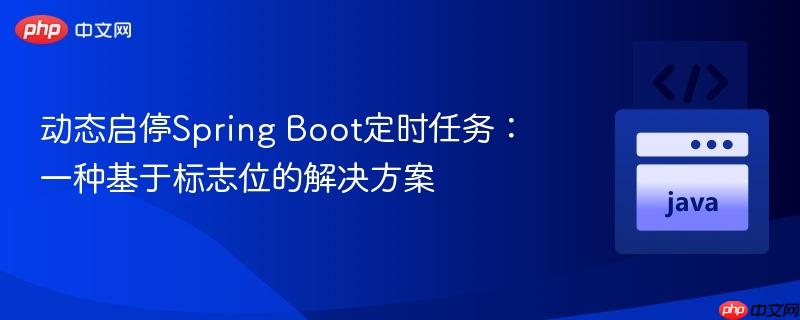
本文档旨在提供一种在Spring Boot应用中动态启停定时任务的实用方法,尤其适用于需要根据客户端配置灵活控制任务执行的场景。核心思想是利用标志位来控制任务的实际执行,避免频繁创建和销毁定时任务,从而简化任务管理并提高系统性能。通过本文,你将了解如何使用`TaskScheduler`和标志位来实现动态任务调度,并掌握相关的代码示例和注意事项。
在Spring Boot应用中,动态启停定时任务的需求十分常见,尤其是在多租户或需要根据用户配置调整任务执行策略的场景下。一种常见的方案是使用TaskScheduler来动态创建和销毁定时任务。然而,频繁地创建和销毁任务可能会带来性能开销。本文将介绍一种基于标志位的解决方案,通过控制任务内部的执行逻辑来实现动态启停的效果,从而避免频繁的任务创建和销毁。
该方案的核心在于,让定时任务始终运行,但通过一个标志位来控制任务内部的实际执行逻辑。当标志位为真时,任务执行其业务逻辑;当标志位为假时,任务直接返回,不执行任何操作。这样,启停任务实际上就是修改标志位的状态,而不是真正地创建或销毁任务。
定义标志位服务:
创建一个服务(例如MyFlagService),用于管理每个客户端的标志位状态。该服务应提供启用(enableScheduler)、禁用(disableScheduler)和查询(isSchedulerEnabled)标志位状态的方法。
import org.springframework.stereotype.Service;
import java.util.Map;
import java.util.concurrent.ConcurrentHashMap;
@Service
public class MyFlagService {
private final Map<String, Boolean> schedulerFlags = new ConcurrentHashMap<>();
public void enableScheduler(String clientId) {
schedulerFlags.put(clientId, true);
}
public void disableScheduler(String clientId) {
schedulerFlags.put(clientId, false);
}
public boolean isSchedulerEnabled(String clientId) {
return schedulerFlags.getOrDefault(clientId, false); // 默认禁用
}
}ConcurrentHashMap用于保证线程安全。
修改Controller:
在Controller中,提供启动和停止API,用于修改标志位服务中的标志位状态。
import org.springframework.beans.factory.annotation.Autowired;
import org.springframework.http.HttpStatus;
import org.springframework.http.ResponseEntity;
import org.springframework.web.bind.annotation.RequestMapping;
import org.springframework.web.bind.annotation.RequestParam;
import org.springframework.web.bind.annotation.RestController;
@RestController
class SchedulerController {
@Autowired
MyFlagService myFlagService;
@RequestMapping("start")
ResponseEntity<Void> start(@RequestParam String clientId) {
myFlagService.enableScheduler(clientId);
return new ResponseEntity<>(HttpStatus.OK);
}
@RequestMapping("stop")
ResponseEntity<Void> stop(@RequestParam String clientId) {
myFlagService.disableScheduler(clientId);
return new ResponseEntity<>(HttpStatus.OK);
}
}实现定时任务:
创建一个定时任务,并在任务内部检查标志位状态。如果标志位为真,则执行业务逻辑;否则,直接返回。
import org.springframework.beans.factory.annotation.Autowired;
import org.springframework.scheduling.annotation.Scheduled;
import org.springframework.stereotype.Component;
@Component
public class MyScheduledTask {
@Autowired
MyFlagService myFlagService;
@Scheduled(fixedDelay = 5000) // 每5秒执行一次
public void myWorkerFunction() {
// 模拟从数据库获取clientId列表
String[] clientIds = {"clientA", "clientB", "clientC"};
for (String clientId : clientIds) {
if (myFlagService.isSchedulerEnabled(clientId)) {
// 执行业务逻辑
System.out.println("Task running for client: " + clientId);
// TODO: Add your business logic here
} else {
System.out.println("Task skipped for client: " + clientId);
}
}
}
}确保你的Spring Boot应用启用了定时任务功能,需要在主类或配置类上添加@EnableScheduling注解。
// MyFlagService.java (如上)
// SchedulerController.java (如上)
// MyScheduledTask.java (如上)
import org.springframework.boot.SpringApplication;
import org.springframework.boot.autoconfigure.SpringBootApplication;
import org.springframework.scheduling.annotation.EnableScheduling;
@SpringBootApplication
@EnableScheduling
public class DemoApplication {
public static void main(String[] args) {
SpringApplication.run(DemoApplication.class, args);
}
}通过利用标志位来控制定时任务的执行,可以避免频繁创建和销毁任务,从而简化任务管理并提高系统性能。该方案适用于需要根据客户端配置灵活控制任务执行的场景。在实际应用中,需要根据具体需求进行适当的调整和优化。这种方法的核心优势在于降低了TaskScheduler的负担,将控制逻辑转移到了任务内部,使得任务的启停更加轻量级。
以上就是动态启停Spring Boot定时任务:一种基于标志位的解决方案的详细内容,更多请关注php中文网其它相关文章!

每个人都需要一台速度更快、更稳定的 PC。随着时间的推移,垃圾文件、旧注册表数据和不必要的后台进程会占用资源并降低性能。幸运的是,许多工具可以让 Windows 保持平稳运行。

Copyright 2014-2025 https://www.php.cn/ All Rights Reserved | php.cn | 湘ICP备2023035733号